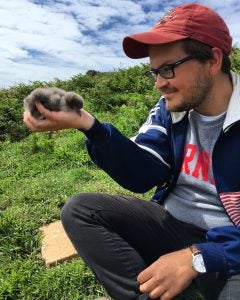THE BOSS
Artyom Kopp
email: akopp@ucdavis.edu

I am interested in the genetic basis of phenotypic evolution and especially in evolutionary innovations – that is, the origin of new morphological structures, developmental processes, and genetic regulatory circuits. Although true novelties are relatively rare, they ultimately shape all the complexity and diversity we see in nature – from geological nutrient cycles that support life to human sentience that occasionally distinguishes us from other animals. Projects in our lab seek to reconstruct the origin of innovations at all levels of biological organization, from new functional elements in the genome to new genetic pathways to entire new organs. I haven’t done an honest day of lab work in a long time (although I still torture flies sometimes), so I live vicariously through my labmates’ projects.
LAB MANAGER
Olga Barmina
email: oybarmina@ucdavis.edu
 The sex comb is a morphological structure on the first leg of some Drosophila males that consists of modified mechanosensory bristles. It is a recent evolutionary innovation and plays an important role in courtship and mating. I am interested in the genetic and molecular mechanisms underlying the origin of morphologically different sex combs. Novel interactions between HOX and sex determination genes seem to play an important role in sex comb evolution. The HOX gene Scr is one of the key genes responsible for the origin of this new sex-specific structure. Right now I am working on a detailed functional dissection and comparative analysis of the regulatory elements of the Scr gene in multiple Drosophila species. This research will yield insight into how morphological innovation evolves.
The sex comb is a morphological structure on the first leg of some Drosophila males that consists of modified mechanosensory bristles. It is a recent evolutionary innovation and plays an important role in courtship and mating. I am interested in the genetic and molecular mechanisms underlying the origin of morphologically different sex combs. Novel interactions between HOX and sex determination genes seem to play an important role in sex comb evolution. The HOX gene Scr is one of the key genes responsible for the origin of this new sex-specific structure. Right now I am working on a detailed functional dissection and comparative analysis of the regulatory elements of the Scr gene in multiple Drosophila species. This research will yield insight into how morphological innovation evolves.
POSTDOCTORAL SCHOLARS
Ben Hopkins
email: brhopkins@ucdavis.edu
 I’m interested in the evolution of novelty, both its developmental genetic basis and associated fitness effects. While the appearance of traits can be modified by changes in the developmental pathways that build them, how new pathways evolve remains unresolved. To understand this process, my work uses a combination of comparative single-cell RNA-sequencing and developmental genetic experiments to reconstruct the evolutionary assembly of a sex-specific innovation: the Drosophila sex comb. I also maintain a strong interest in the evolution of reproductive traits more broadly, which was the focus of my PhD work at the University of Oxford. My work is funded by a long-term fellowship from the Human Frontier Science Program Organization.
I’m interested in the evolution of novelty, both its developmental genetic basis and associated fitness effects. While the appearance of traits can be modified by changes in the developmental pathways that build them, how new pathways evolve remains unresolved. To understand this process, my work uses a combination of comparative single-cell RNA-sequencing and developmental genetic experiments to reconstruct the evolutionary assembly of a sex-specific innovation: the Drosophila sex comb. I also maintain a strong interest in the evolution of reproductive traits more broadly, which was the focus of my PhD work at the University of Oxford. My work is funded by a long-term fellowship from the Human Frontier Science Program Organization.
Yuichi Fukutomi
email: yfukutomi@ucdavis.edu
 What I’m interested in is genetic basis of morphological evolution. Especially, I would like to understand the mechanisms that produce morphological novelties and the differences between species and sexes at the molecular and cellular levels. For that, studying the pigmentation patterns of different Drosophila species can be one of the best approaches. As a PhD student, I worked on polka-dotted wing pigmentation of Drosophila guttifera to study the developmental mechanisms responsible for the emergence of novel color pattern. In this lab, I am working on the abdominal pigmentation in the Drosophila montium species group, and studying the genetic basis of evolution of female-limited polymorphisms and dominance reversals.
What I’m interested in is genetic basis of morphological evolution. Especially, I would like to understand the mechanisms that produce morphological novelties and the differences between species and sexes at the molecular and cellular levels. For that, studying the pigmentation patterns of different Drosophila species can be one of the best approaches. As a PhD student, I worked on polka-dotted wing pigmentation of Drosophila guttifera to study the developmental mechanisms responsible for the emergence of novel color pattern. In this lab, I am working on the abdominal pigmentation in the Drosophila montium species group, and studying the genetic basis of evolution of female-limited polymorphisms and dominance reversals.
